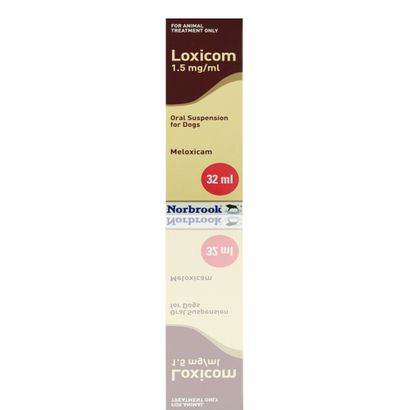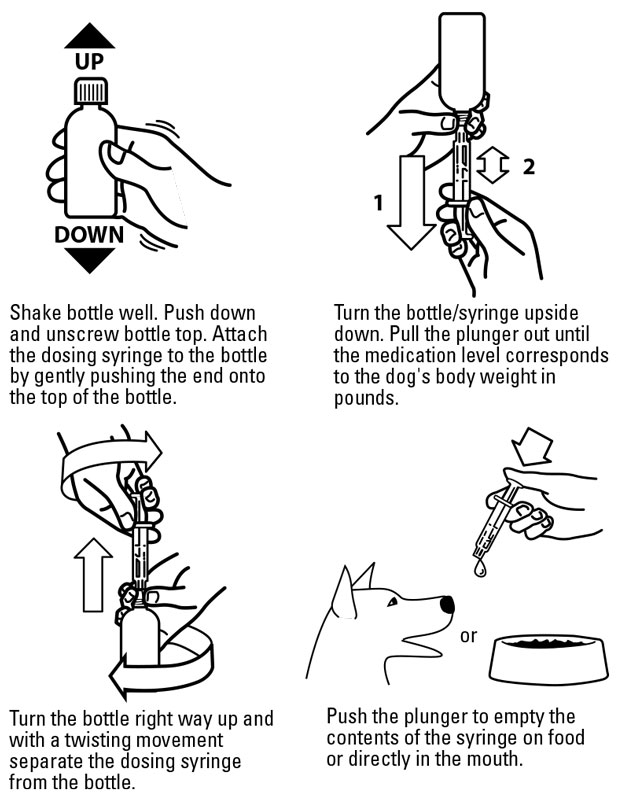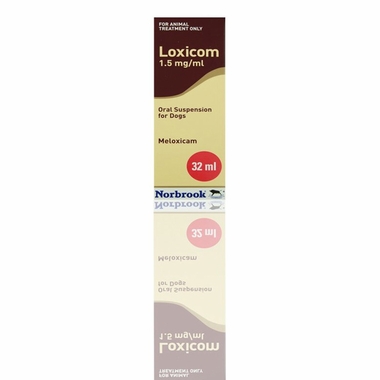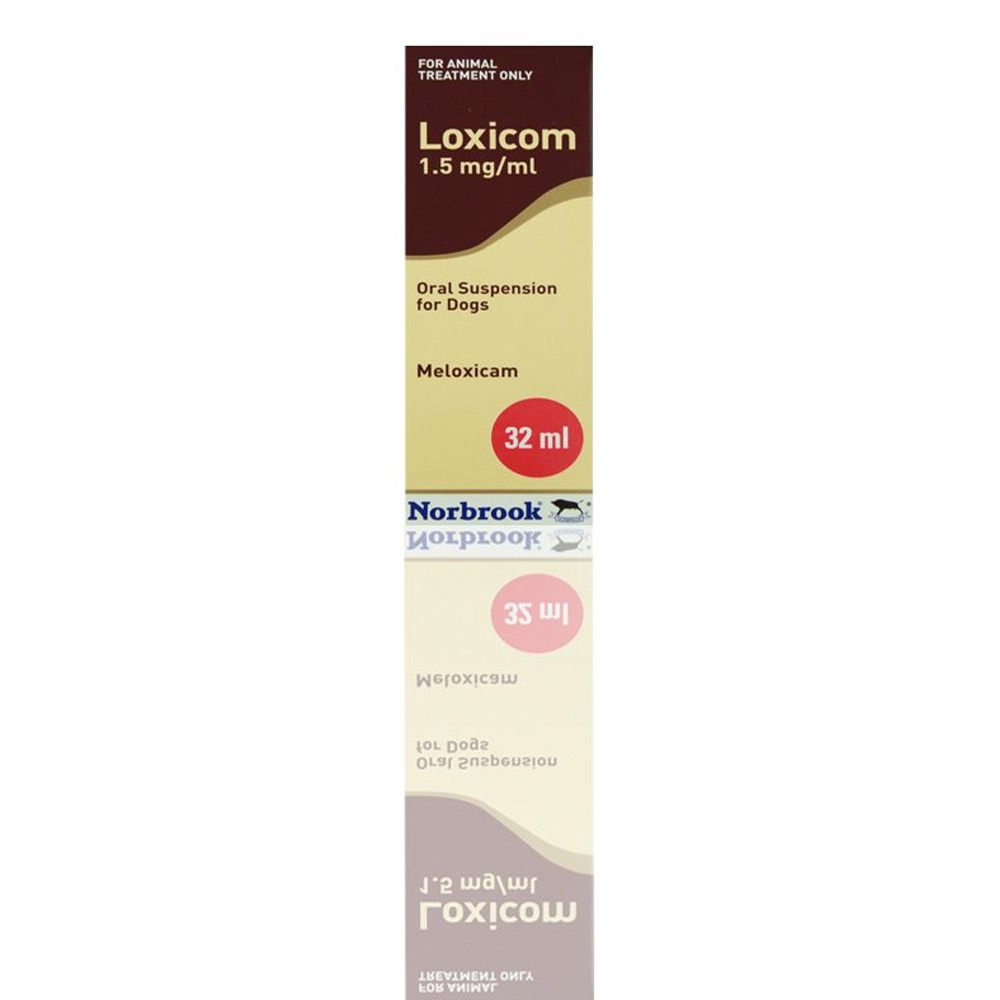SAVE 20% OFF 20% OFF Use Code NY26 *

Loxicom Oral Solution 1.5MG (32 ml)
- Description
- Directions
- FAQ
- Reviews
Description
Loxicom is a non-steroidal anti-inflammatory (NSAID) used to control pain and inflammation associated with osteoarthritis in dogs. Loxicom may also be used for purposes other than those listed here. This oral suspension comes with two sizes of dosing syringes to make administering easy for small and large dogs. Loxicom is available in 10 ml, 32 ml, and 100 ml bottles and requires a prescription from your veterinarian.
Key Benefits
- Helps control pain and inflammation associated with osteoarthritis
- Easy-to-administer dosing syringe
How it works
Loxicom works by reducing hormones that cause pain and inflammation in the body.
Indications and Usage
Loxicom Oral Suspension is indicated for the control of pain and inflammation associated with osteoarthritis in dogs.
Directions
View Loxicom Drug Facts Sheet.
Always provide client information sheet with prescription. Carefully consider the potential benefits and risk of Loxicom Oral Suspension and other treatment options before deciding to use Loxicom Oral Suspension. Use the lowest effective dose for the shortest duration consistent with individual response. Loxicom Oral Suspension should be administered initially at 0.09 mg/lb (0.2 mg/kg) body weight only on the first day of treatment. For all treatments after day 1, Loxicom Oral Suspension should be administered once daily at a dose of 0.045 mg/lb (0.1 mg/ kg). The syringes are calibrated to deliver the daily maintenance dose in lbs. Because the first dose (0.2 mg/kg) is two times the amount of the daily maintenance dose (0.1 mg/kg), two syringes containing the 0.1 mg/kg dose should be administered at the first dose.
Directions for Administration:
Loxicom Oral Suspension is packaged with 2 sizes of dosing syringes. The small syringe is calibrated in 1-lb increments for use in dogs under 30 lbs. The large syringe is calibrated in 5-lb increments (up to 160 lbs.) and should be used for dosing dogs that are 30 lbs and over. Only administer Loxicom with theprovided syringes. The container should never be used as a dropper bottle for administration of Loxicom.
Dogs under 30 lbs (13.6 kg)
Shake well before use, then remove cap. Loxicom Oral Suspension can be given either mixed with food or placed directly into the mouth. Particular care should be given with regard to the accuracy of dosing. To prevent accidental overdosing of small dogs, only use the small dosing syringe. The large syringe provided should not be used to measure doses for dogs weighing less than 30 lbs (13.6 kg). For dogs under 30 lbs, use the small dosing syringe provided in the package (see dosing procedure below). The small dosing syringe fits onto the bottle and has dosing marks in 1-lb increments, designed to deliver the daily maintenance dose of 0.045 mg/lb (0.1 mg/kg). For dogs between 1 - 29 lbs, Loxicom can be given using the marks on the small dosing syringe. When using the small dosing syringe, the dog’s weight should be rounded down to the nearest 1-lb increment. Replace and tighten cap after use.
Dogs 30 lbs (13.6 kg) and over
Shake well before use, then remove cap. Loxicom may be either mixed with food or placed directly into the mouth. Particular care should be given with regard to the accuracy of dosing. To prevent accidental overdosing of small dogs, do not use the large syringe in animals weighing less than 30 pounds. For dogs 30 lbs or greater, the large dosing syringe provided in the package should be used (see dosing procedure below). The large dosing syringe fits onto the bottle and has dosing marks in 5-lb increments (up to 160 lbs), designed to deliver the daily maintenance dose of 0.045 mg/lb (0.1 mg/kg). When using the large syringe, the dog’s weight should be rounded down to the nearest 5-lb increment. Replace and tighten cap after use.

Caution:
Federal law restricts this drug to use by or on the order of a licensed veterinarian.
Warning:
Repeated use of meloxicam in cats has been associated with acute renal failure and death. Do not administer additional injectable or oral meloxicam to cats. See Contraindications, Warnings, and Precautions for detailed information.
Contraindications:
Dogs with known hypersensitivity to meloxicam should not receive Loxicom Oral Suspension. Do not use Loxicom Oral Suspension in cats. Acute renal failure and death have been associated with the use of meloxicam in cats.
Warnings:
Not for use in humans. Keep this and all medications out of reach of children. Consult a physician in case of accidental ingestion by humans. For oral use in dogs only.
As with any NSAID all dogs should undergo a thorough history and physical examination before the initiation of NSAID therapy. Appropriate laboratory testing to establish hematological and serum biochemical baseline data is recommended prior to and periodically during administration. Owner should be advised to observe their dog for signs of potential drug toxicity and be given a client information sheet about Loxicom.
Precautions:
The safe use of Loxicom Oral Suspension in dogs younger than 6 months of age, dogs used for breeding, or in pregnant or lactating dogs has not been evaluated. Meloxicam is not recommended for use in dogs with bleeding disorders, as safety has not been established in dogs with these disorders. As a class, cyclo-oxygenase inhibitory NSAIDs may be associated with gastrointestinal, renal and hepatic toxicity. Sensitivity to drug-associated adverse events varies with the individual patient.
Dogs that have experienced adverse reactions from one NSAID may experience adverse reactions from another NSAID. Patients at greatest risk for renal toxicity are those that are dehydrated, on concomitant diuretic therapy, or those with existing renal, cardiovascular, and/or hepatic dysfunction. Concurrent administration of potentially nephrotoxic drugs should be carefully approached. NSAIDs may inhibit the prostaglandins that maintain normal homeostatic function. Such anti-prostaglandin effects may result in clinically significant disease in patients with underlying or pre-existing disease that has not been previously diagnosed. Since NSAIDs possess the potential to induce gastrointestinal ulcerations and/or perforations, concomitant use with other anti-inflammatory drugs, such as NSAIDs or corticosteroids, should be avoided. If additional pain medication is needed after administration of the total daily dose of Loxicom Oral Suspension, a non-NSAID or non-corticosteroid class of analgesia should be considered. The use of another NSAID is not recommended. Consider appropriate washout times when switching from corticosteroid use or from one NSAID to another in dogs. The use of concomitantly protein-bound drugs with Loxicom Oral Suspension has not been studied in dogs. Commonly used protein-bound drugs include cardiac, anticonvulsant and behavioral medications. The influence of concomitant drugs that may inhibit metabolism of Loxicom Oral Suspension has not been evaluated. Drug compatibility should be monitored in patients requiring adjunctive therapy.
Information for Dog Owners
Loxicom, like other drugs of its class, is not free from adverse reactions. Owners should be advised of the potential for adverse reactions and be informed of the clinical signs associated with drug intolerance. Adverse reactions may include vomiting, diarrhea, decreased appetite, dark or tarry stools, increased water consumption, increased urination, pale gums due to anemia, yellowing of gums, skin or white of the eye due to jaundice, lethargy, incoordination, seizure, or behavioral changes. Serious adverse reactions associated with this drug class can occur without warning and in rare situations result in death (see Adverse Reactions). Owners should be advised to discontinue Loxicom and contact their veterinarian immediately if signs of intolerance are observed.
The vast majority of patients with drug related adverse reactions have recovered when the signs are recognized, the drug is withdrawn, and veterinary care, if appropriate, is initiated. Owners should be advised of the importance of periodic follow up for all dogs during administration of any NSAID.
Clinical Pharmacology:
Meloxicam has nearly 100% bioavailability when administered orally with food. The terminal elimination half-life after a single dose is estimated to be approximately 24 hrs (+/-30%) regardless of route of administration. There is no evidence of statistically significant gender differences in drug pharmacokinetics. Drug bioavailability, volume of distribution, and total systemic clearance remain constant up to 5 times the recommended dose for use in dogs. However, there is some evidence of enhanced drug accumulation and terminal elimination half-life prolongation when dogs are dosed for 45 days or longer.
Peak drug concentrations can be expected to occur within about 7.5 hrs after oral administration. Corresponding peak concentration is approximately 0.464 mcg/mL following a 0.2 mg/kg oral dose. The drug is 97% bound to canine plasma proteins.
Effectiveness:
The effectiveness of meloxicam was demonstrated in two field studies involving a total of 277 dogs representing various breeds, between six months and sixteen years of age, all diagnosed with osteoarthritis. Both of the placebo-controlled, masked studies were conducted for 14 days. All dogs received 0.2 mg/kg on day 1. All dogs were maintained on 0.1 mg/kg oral meloxicam from days 2 through 14 of both studies. Parameters evaluated by veterinarians included lameness, weight-bearing, pain on palpation, and overall improvement. Parameters assessed by owners included mobility, ability to rise, limping, and overall improvement. In the first field study (n=109), dogs showed clinical improvement with statistical significance after 14 days of meloxicam treatment for all parameters. In the second field study (n=48), dogs receiving meloxicam showed a clinical improvement after 14 days of therapy for all parameters; however, statistical significance was demonstrated only for the overall investigator evaluation on day 7, and for the owner evaluation on day 14.
Storage:
Store at controlled room temperature 68-77°F (20-25°C). Excursions permitted between 59°F and 86°F (15°C and 30°C). Brief exposure to temperature up to 104° F (40°C) may be tolerated provided the mean kinetic temperature does not exceed 77°F (25°C); however such exposure should be minimized.


